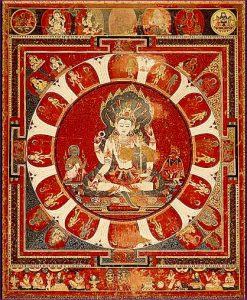|
If one could produce a graphic image of the whole of human nature, many different forms might be integrated within an overall shape, such as a circle or square. Also, if it were possible to have a visual presentation of a person’s inner world of mind, weaknesses, strengths, order, confusion, and quality, each person would appear differently. Some would be internally jumbled, divided and ugly; others symmetrical, integrated and beautiful.
| Because the unconscious produces dreams, and because dreams are imagery that give form to the otherwise abstract elements of internal human nature, there arise in some dreams shapes or patterns which depict an overall view of ones own inner condition. Carl Jung drew attention to the circle and square designs in some dreams, calling them mandalas – which is a Sanskrit word meaning circle, and referring to religious symbols – and seeing them as representing the nucleus of the human identity. Although we are, in our everyday life, the magical and mysterious process of life, it is difficult for us to actually answer the question ‘Who am I’? or ‘What am I’? with any lasting conviction.
The mysterious essence of ourselves is met in dreams as a circular or square object or design; as the sun, a flower, a square garden with a round pond in the middle, or a circle with a square or quartered design within it, a circle with cross within, a revolving or flying cross shaped object. Classical symbols from all nations use this theme, and we can find it in the Round Table of king Arthur, in the centre of which the Holy Grail appeared; the healing sand paintings of the Navaho Indians; the zodiac; circle dances; stone circles; the Buddhist wheel of birth and death; and so on. |
|
|
|
|
|
The circle usually symbolises a natural wholeness, our inner life as nature has shaped it. The square shows wholeness we have helped shape by conscious co-operation with our inner world or the healing power of the Self. There are two main reasons why one produces this theme in ones dreams. It occurs in children or people meeting internal or external shocks, and produces a strengthening of the vulnerable identity in meeting the varied influences they face. It arises in people who are meeting and integrating the wider life of their being existing beyond the boundaries of their usual interests, or what they allow themselves to experience. The contact with the Self is then part of an extending of awareness into what was dark or unknown, not only in ones own unconscious, but in external life. In touching the nucleus of ones being in this way, one becomes aware in some measure of the infinite potential of ones life. There is often an accompanying sense of existence in eternity and the many different ‘mansions’ or dimensions of experience one has within the eternal. See: self under archetypes; yoga and dreams.
An example of an experience of a living Mandala:
I looked up at the wall above the bed. It was an unlikely shade of green, but what was remarkable was that on the clear expanse of the wall I could see a huge circle, alive and full of movement. My attention was riveted by this amazing circle. At its centre was an unmoving emptiness, nothingness. Yet out of this void sprung all the forms of life as plants, trees, animals and people. They were constantly emerging from the pool of emptiness, dancing in time to music. All this stream of emerging life moved weaving in time with the sound, in and out of the other each other to the periphery of the great circle. Here it turned and with equal complexity and rhythm moved back to the void. At its return it was lost, dissolved, in that unmoving emptiness, and yet at the same moment new living creators and landscape was born from the apparently nothingness. As I witnessed the whole moving circle I realised it portrayed a great truth of life. D. D.
What D. D. describes is a powerful symbol not of just one aspect of himself or his life. The symbol encompasses birth life and death. It portrays origins and goals. It is personal in that D. D. can identify his own existence as being part of a vast connected movement of life and creation, and yet the symbol also refers to life in a universal sense. Such a symbol therefore incorporates vast amounts of vision or information. See Void – Archetype of the
These transforming symbols need not be in the form of a mandala as with the circle in the example.

|
|

